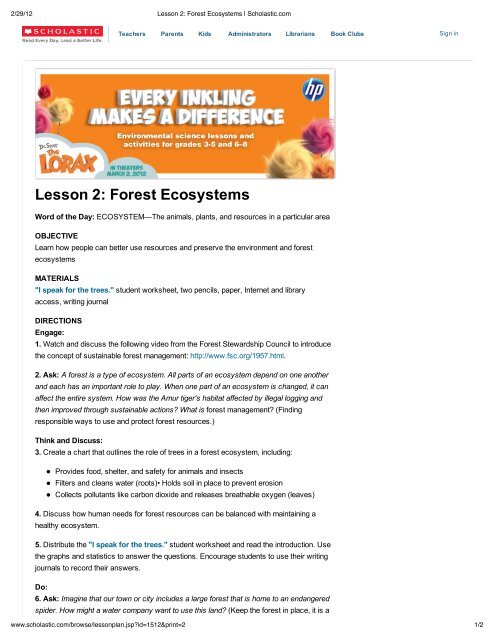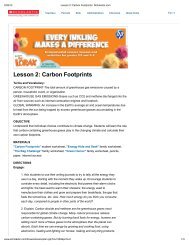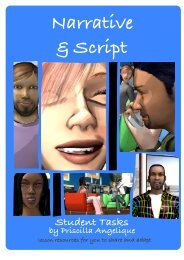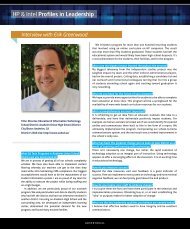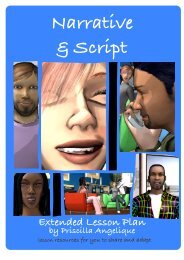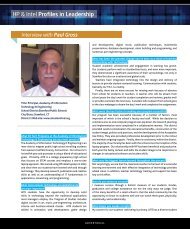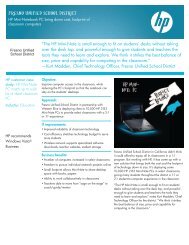Lesson 2: Forest Ecosystems - Digital Learning Environments
Lesson 2: Forest Ecosystems - Digital Learning Environments
Lesson 2: Forest Ecosystems - Digital Learning Environments
You also want an ePaper? Increase the reach of your titles
YUMPU automatically turns print PDFs into web optimized ePapers that Google loves.
2/29/12 <strong>Lesson</strong> 2: <strong>Forest</strong> <strong>Ecosystems</strong> | Scholastic.com<br />
Teachers Parents Kids Administrators Librarians Book Clubs Sign in<br />
<strong>Lesson</strong> 2: <strong>Forest</strong> <strong>Ecosystems</strong><br />
Word of the Day: ECOSYSTEM—The animals, plants, and resources in a particular area<br />
OBJECTIVE<br />
Learn how people can better use resources and preserve the environment and forest<br />
ecosystems<br />
MATERIALS<br />
"I speak for the trees." student worksheet, two pencils, paper, Internet and library<br />
access, writing journal<br />
DIRECTIONS<br />
Engage:<br />
1. Watch and discuss the following video from the <strong>Forest</strong> Stewardship Council to introduce<br />
the concept of sustainable forest management: http://www.fsc.org/1957.html.<br />
2. Ask: A forest is a type of ecosystem. All parts of an ecosystem depend on one another<br />
and each has an important role to play. When one part of an ecosystem is changed, it can<br />
affect the entire system. How was the Amur tiger's habitat affected by illegal logging and<br />
then improved through sustainable actions? What is forest management? (Finding<br />
responsible ways to use and protect forest resources.)<br />
Think and Discuss:<br />
3. Create a chart that outlines the role of trees in a forest ecosystem, including:<br />
Provides food, shelter, and safety for animals and insects<br />
Filters and cleans water (roots)• Holds soil in place to prevent erosion<br />
Collects pollutants like carbon dioxide and releases breathable oxygen (leaves)<br />
4. Discuss how human needs for forest resources can be balanced with maintaining a<br />
healthy ecosystem.<br />
5. Distribute the "I speak for the trees." student worksheet and read the introduction. Use<br />
the graphs and statistics to answer the questions. Encourage students to use their writing<br />
journals to record their answers.<br />
Do:<br />
6. Ask: Imagine that our town or city includes a large forest that is home to an endangered<br />
spider. How might a water company want to use this land? (Keep the forest in place, it is a<br />
www.scholastic.com/browse/lessonplan.jsp?id=1512&print=2<br />
1/2
2/29/12 <strong>Lesson</strong> 2: <strong>Forest</strong> <strong>Ecosystems</strong> | Scholastic.com<br />
natural filter for the local water supply.) How might a builder want to use it? (Use it for wood<br />
for homes or land for building.)<br />
7. Instruct students to take on the role of someone within this fictional community such as a<br />
kid, parent, tourist, builder, forest manager, scientist, farmer, or water company executive.<br />
Ask students to think about how their character would want to use this land. Students<br />
should work together to create a sustainable plan that meets the needs of everyone in the<br />
community.<br />
Click here for additional teaching materials and resources about forest ecosystems and<br />
sustainable forest management.<br />
School to Home<br />
Products & Services<br />
Online Shopping<br />
Book Clubs<br />
Book Fairs<br />
Classroom Resources<br />
Book Lists<br />
Book Wizard<br />
Instructor Magazine<br />
<strong>Lesson</strong> Plans<br />
New Books<br />
New Teachers<br />
Scholastic News Online<br />
Kids Press Corps<br />
Strategies and Ideas<br />
Student Activities<br />
Daily Teacher Blogs<br />
Videos<br />
Whiteboard Resources<br />
Author Visit Program<br />
Classroom Books<br />
Classroom Magazines<br />
Find a Sales Representative<br />
Free Programs and Giveaways<br />
Guided Reading<br />
Math Intervention<br />
Product Information<br />
Read 180<br />
Reading is Fundamental<br />
Request a Catalog<br />
Scholastic Professional<br />
Tom Snyder Productions<br />
List Builder<br />
Printables<br />
Teacher Express<br />
Teacher Store<br />
Get updates, savings, and more<br />
Enter Email Address<br />
Select Grade<br />
See a sample ><br />
About Scholastic<br />
Our Website<br />
Need Help?<br />
Join Us Online<br />
Who We Are<br />
Corporate Responsibility<br />
Media Room<br />
Investor Relations<br />
International<br />
Scholastic en Español<br />
Careers<br />
Teachers<br />
Parents<br />
The Stacks (Ages 8-12)<br />
Family Playground (Ages 3-7)<br />
Librarians<br />
Administrators<br />
Product Information<br />
Customer Service<br />
Contact Us<br />
PRIVACY POLICY ! Terms of Use ! TM ® & © 2012 Scholastic Inc. All Rights Reserved.<br />
New Site Features<br />
www.scholastic.com/browse/lessonplan.jsp?id=1512&print=2<br />
2/2


